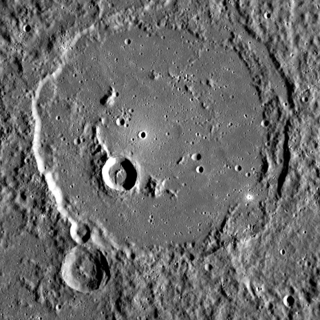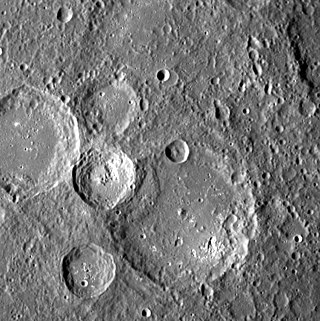
Lermontov is an impact crater on the planet Mercury. The crater is named after Mikhail Yuryevich Lermontov, a 19th-century Russian poet. The name was approved by the International Astronomical Union in 1976.

Kuiper is a moderate-size crater with a central peak cluster located at 11.35°S 31.23°W on Mercury. It is 62 kilometers in diameter and was named after Dutch-American astronomer Gerard Kuiper in 1976. It is one of only 2 Mercurian craters which are named not after artists, and one of very few cases when the same name is used for 3 craters. Gerard Kuiper, being a leader of American planetary science, died shortly before the first images of Mercurian surface were made.

Tolstoj is a large, ancient impact crater on Mercury. It was named after Leo Tolstoy by the IAU in 1976. The albedo feature Solitudo Maiae appears to be associated with this crater.

Boethius is a crater on the planet Mercury. It was named after Anicius Manlius Severinus Boethius, the Roman philosopher, by the IAU in 1976. The crater was first imaged by Mariner 10 in 1974.

Hun Kal is a small crater on Mercury that serves as the reference point for the planet's system of longitude. The longitude of Hun Kal's center is defined as being 20° W, thus establishing the planet's prime meridian. The name "Hun Kal" means '20' in the language of the Maya.

Bashō is a crater on Mercury named after Matsuo Bashō, a 17th-century Japanese writer. Bashō crater is only 74.62 kilometers (46.37 mi) in diameter, but is a prominent feature on Mercury's surface, due to its bright rays. Photographs from NASA's Mariner 10 and MESSENGER spacecraft show a curious halo of dark material around the crater. The dark material is typically referred to as low-reflectance material (LRM) and there is evidence that it is caused by graphite.

Polygnotus is a crater on Mercury, named by the IAU in 1976, after ancient Greek painter Polygnotus. The crater was first imaged by Mariner 10 in 1974.

Titian is an impact crater on the planet Mercury. It was named by the IAU in 1976.

Berkel is a crater on the planet Mercury. Its name was approved by the IAU on July 9, 2009. It was named after the modernist painter Sabri Berkel.

Scarlatti is a pit-floored crater on Mercury, which was discovered in 1974 by the Mariner 10 spacecraft. It has a prominent peak ring, and it is one of 110 peak ring basins on Mercury. The crater floor is covered by the smooth plains material. The crater displays an arcuate collapse feature along the northeastern peak ring. The size of the pit, which was first noticed in MESSENGER images obtained in January 2008, is 38 × 12 km. Such a feature may have resulted from collapse of a magma chamber underlying the central peak ring complex of the crater. The collapse feature is an analog of Earth's volcanic calderas. Scarlatti is thought to have the same age as the Caloris basin.

Calvino is a crater on Mercury. Its name was adopted by the IAU in 2016, after the Italian writer Italo Calvino.

Dominici is a crater on Mercury. It was named by the IAU in 2010.

Ailey is a crater on Mercury. It has a diameter of 21 kilometers. Its name was adopted by the International Astronomical Union (IAU) in on April 24, 2012. Ailey is named for the American dancer and choreographer Alvin Ailey, who lived from 1931 to 1989.

Chaikovskij is a crater on Mercury. It has a diameter of 171 kilometers. Its name was adopted by the International Astronomical Union (IAU) in 1976. Chaikovskij is named for the Russian composer Pyotr Ilyich Tchaikovsky, who lived from 1840 to 1893.

Han Kan is a crater on Mercury. It has a diameter of 50 kilometers. Its name was adopted by the International Astronomical Union (IAU) in 1985. Han Kan is named for the Chinese painter Han Gan, who lived from 720 to 780.

Keats is a crater on Mercury. The crater's name was adopted by the International Astronomical Union (IAU) in 1976 and named after an English poet. This poet is known as John Keats, who lived from 1795 to 1821.

Mistral is a crater on Mercury. Its name was adopted by the International Astronomical Union (IAU) in 1976. Mistral is named for the Chilean poet Gabriela Mistral, who lived from 1889 to 1957.

Nureyev is a crater on Mercury. It has a diameter of 16 kilometers, and has a bright and extensive ray system. Its name was adopted by the International Astronomical Union (IAU) on April 24, 2012. Nureyev is named for the Soviet and British ballet dancer Rudolf Nureyev.

Motonobu is a crater on Mercury. Its name was adopted by the International Astronomical Union (IAU) on August 13, 2024, for the Japanese painter and calligrapher, Kanō Motonobu, who lived from 1476 to 1559. The crater was first imaged by Mariner 10 in 1974.






















